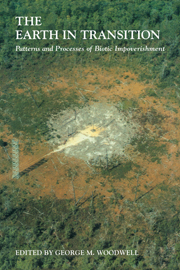Book contents
- Frontmatter
- Contents
- Preface
- Acknowledgments
- List of Contributors
- Part I Global Change and the Patterns of Impoverishment
- Part II Chronic Disturbance and Natural Ecosystems: Forests
- 8 The Restoration of Nonsuch Island as a Living Museum of Bermuda's Precolonial Terrestrial Biome
- 9 Patterns of Impoverishment in Natural Communities: Case History Studies in Forest Ecosystems – New Zealand
- 10 Changes in the Eucalypt Forests of Australia as a Result of Human Disturbance
- 11 Impoverishment in Pacific Island Forests
- 12 Deforestation in Brazilian Amazonia
- 13 Incentives for Sustainable Forest Management
- Part III Chronic Disturbance and Natural Ecosystems: Woodlands, Grasslands, and Tundra
- Part IV Chronic Disturbance and Natural Ecosystems: Aquatic and Emergent Ecosystems
- Part V Conclusion: Steps toward a World That Runs Itself
- Name Index
- Subject Index
10 - Changes in the Eucalypt Forests of Australia as a Result of Human Disturbance
Published online by Cambridge University Press: 24 November 2009
- Frontmatter
- Contents
- Preface
- Acknowledgments
- List of Contributors
- Part I Global Change and the Patterns of Impoverishment
- Part II Chronic Disturbance and Natural Ecosystems: Forests
- 8 The Restoration of Nonsuch Island as a Living Museum of Bermuda's Precolonial Terrestrial Biome
- 9 Patterns of Impoverishment in Natural Communities: Case History Studies in Forest Ecosystems – New Zealand
- 10 Changes in the Eucalypt Forests of Australia as a Result of Human Disturbance
- 11 Impoverishment in Pacific Island Forests
- 12 Deforestation in Brazilian Amazonia
- 13 Incentives for Sustainable Forest Management
- Part III Chronic Disturbance and Natural Ecosystems: Woodlands, Grasslands, and Tundra
- Part IV Chronic Disturbance and Natural Ecosystems: Aquatic and Emergent Ecosystems
- Part V Conclusion: Steps toward a World That Runs Itself
- Name Index
- Subject Index
Summary
Editor's Note: The eucalypt forests of Australia have evolved to occupy a narrow habitat of restricted nutrient and water availability. They have proven vulnerable to fire, the introduction of exotics, and to the eutrophication that accompanies human activities. They are also vulnerable to a host of aggressive, introduced annuals that are more responsive to the nutrients and that carry fires through the forest at unusual times and in novel ways. The effect is the replacement of the forest by grasslands made up of exotics, a pattern of impoverishment now recognized as common around the world. But the special sensitivity of these forests and those of New Zealand sets them apart as a lesson in both the details of evolution and in the importance of knowledge of those details in management of a potentially rich, productive, and enduring resource that is now rapidly being lost. The loss is through a classical series of stages of impoverishment and results in a conspicuous loss in the capacity of the land for support of people.
R. L. Specht is a distinguished ecologist, long a student of the vegetation of Australia. He writes here about the transitions he has observed in forests in response to cumulative human disturbance.
Introduction
Eucalypt Forests/Woodlands in Australia
Only a quarter of the continent of Australia has the subhumid to perhumid climate favorable to eucalypt-dominated open-forests and woodlands (Table 10.1 and Figure 10.1).
Information
- Type
- Chapter
- Information
- The Earth in TransitionPatterns and Processes of Biotic Impoverishment, pp. 177 - 198Publisher: Cambridge University PressPrint publication year: 1991
